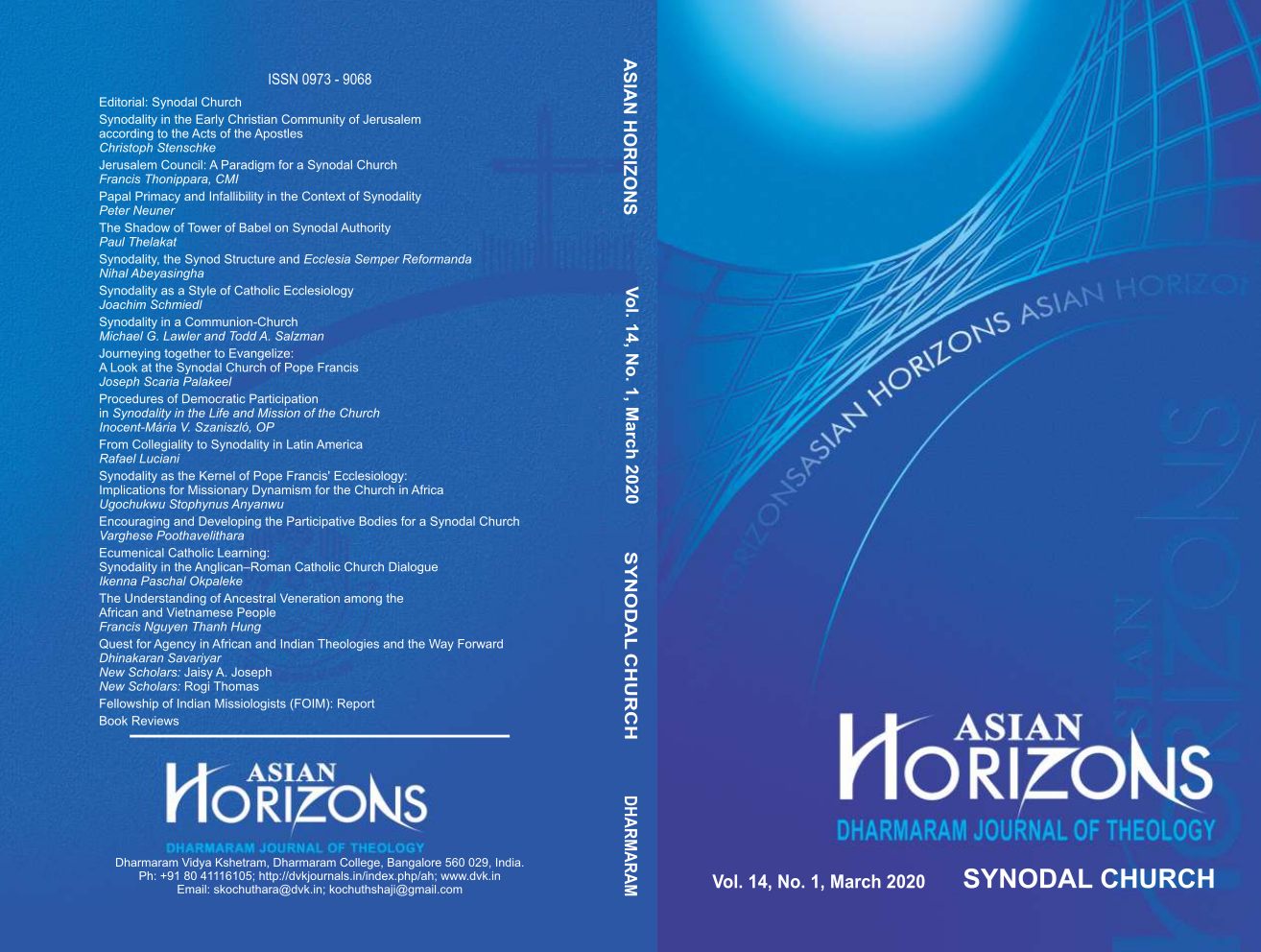Jerusalem Council: A Paradigm for a Synodal Church
Keywords:
Antioch, Collegiality, Jerusalem Council, Communion, German Synod, Pope Francis, Pyramidal Church, Second Vatican Council, SynodalityAbstract
The essence of Christian religion is communion. Synodal and conciliar activities were very common in the history of the first millennium Church. The Jerusalem Council (49 CE) is a paradigm for regaining the collegial, or synodal or participatory character of the Church where all layers of faithful were consulted before arriving at a solution by the “Apostles and Elders.”
The greatest ecclesiological contribution of the Second Vatican Council is the re-discovery of the communion and collegial character of the Church. The establishment of the Synod of Bishops and its regular meetings to a great extent express the collegial character of the Church. Pope Francis is very much for a synodal Church. Through his Apostolic Constitution Episcopalis Communio (2019) expressed his desire for the synodal Church, taking lot of inspiration from the Jerusalem Council. Going back to the Jerusalem Council model of the functioning of the Church will also encourage ecumenism. The Spirit’s abiding presence in the Church guiding it to all truth is seen when the Church comes together in council.
References
Norman P. Tanner, SJ, ed., Decrees of the Ecumenical Councils, Vol. I, London: Sheed & Ward, 1990, 108.
Philip Schaff, History of the Christian Church, Vol. I, Apostolic Christianity, Grand Rapids, Michigan: WMB Eerdmans Publishing Company, 1988 (Reprint), 338.
Schaff, History of the Christian Church, Vol. I, Apostolic Christianity, 340.
Dale T. Irvin, Scott W. Sunquist, World Christian Movement, Vol. I, Maryknoll, New York: Orbis Books, 2001, 29.
Norman Tanner, New Short History of the Catholic Church, London: Burns & Oates, 2011, 7.
Karl Bihlmeyer, Church History, Volume One, Christian Antiquity, Westminster: The Newman Press, 55.
Philip Hughes, A History of the Church, Vol. I, London: Sheed and Ward, 1983 (Reprint), 45-46.
James Lietzmann, A History of the Early Church, Vol. I, Cambridge: James Clarke & Co., 1993, 161.
International Theological Commission, Synodality in the Life and Mission of the Church, (March 2, 2018), Vatican, no. 20.
Norman Tanner, Was the Church too Democratic? Bangalore, Dharmaram Publications, 2003, 5-7.
Karl Bihlmeyer, Church History, Vol. II, The Middle Ages, Westminster: The Newman Press, 1967, 379-395.
Kuncheria Pathil, Pope Francis and his Vision of the Church, Bengaluru: Dharmaram Publications, 2018, 30.
“Pope Francis Wants ‘Poor Church for the Poor,” BBC News, 16 March 2013, https://www.bbc.com/news/world-europe-21812545
Evangelii Gaudium, nos. 198-199.
Pope Francis, The Church of Mercy, ed., Guiliano Vigini, Bengaluru: ATC, 2014 (Reprinted; first published by Darton Longmann & Todd), 123.
Synodality in the Life and Mission of the Church, no. 2.
Episcopalis Communio, no. 4, homily at the Mass for the closing of the VI Ordinary General Assembly of the Synod of Bishops, October 29, 1983.
Episcopalis Communio, no. 6.
Episcopalis Communio, no. 7, Address on the Fifteenth Anniversary of the Synod of Bishops; Cfr., Evangelii Gaudium, 31.
Episcopalis Communio, no. 10; John Paul II, Encyclical Letter Ut unum Sint, May 25, 1995, 95.
Synodality in the Life and Mission of the Church, no. 116.
Letter of the Holy Father Pope Francis to the People of God which is on the Way in Germany, no. 2, 3 & 7, Vatican: Libreria Editrice Vaticana, 2019.
Hans Feichtinger, “First Things as the Synodal Way Begins,” 2.10.2020.https://www.firstthings.com/web-exclusives/2020/02/as-the-synodal-way-begins
Maximos Athiorgoussis, “Theological and Historical Aspects of Conciliarity: Some Propositions for Discussion,” The Greek Orthodox Theological Review 24, 1 (1979) 5.

